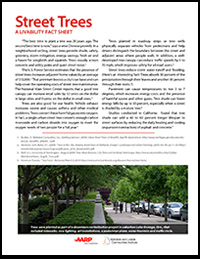AARP Hearing Center
Is there a tree on the street where you live? Hopefully there's a least one tree, ideally there are many!
In a neighborhood setting, street trees provide shade, safety, greenery, storm mitigation, energy savings and fresh air. Trees also buffer street noise, enhance privacy and help hide unattractive views. (What would you rather look at? A tree or a brick wall?)
The U.S. Forest Service estimates that the presence of street trees increases adjacent home values by an average of $13,000. The National Main Street Center reports that a good tree canopy can increase retail sales by 12 cents on the dollar in large cities and 9 cents on the dollar in small ones
Key Points
Among the benefits of tree-lined streets:
- Motorists respond to vertical walls of greenery by driving more slowly, which makes pedestrians and motorists safer.
- Street safety comparisons show a reduction of run-off-the-road crashes and overall crash severity when stretches of a road with street trees are compared with similar segments that have no trees.
- A Texas study found a 46 percent decrease in crash rates across urban arterial and highway sites after landscape improvements were installed.
- The presence of trees in a suburban landscape reduced the cruising speed of drivers by an average of 3 mph.
- U.S. Forest Service research suggests that urban trees may be 10 times as effective as forest trees for lowering carbon dioxide.
- New York City’s 2006 tree census found that its 592,130 street trees provided an estimated $122 million in benefits annually
If some of these facts inspire you to plant a tree on your street (or to ask your municiipality to plant some trees), allow 15 to 30 feet between trees.
One of the real life examples provided in the fact sheet is about efforts in Shreveport, LA., by NeighborWoods, a national program dedicated to reforesting city greenspaces.
Beginning in 2006 student-led volunteers planted more than 20,000 trees in Shreveport, with a particular focus on three at-risk neighborhoods that had moderate to severe crime rates and a lack of community cohesion. By increasing the canopy cover, Shreveport Green offered residents a cooler and more attractive environment, which encouraged them to mingle outside and positively interact with their neighbors. The effort produced a cost benefit to Shreveport of $7.28 for every dollar spent.
How to Use
Because the fact sheets in the Livability series are only four pages each, the materials are quick and easy to read online or to download and print for sharing.
The Parking fact sheet can be used by policy makers, transportation planners, community leaders and citizen activists to educate themselves and others about the importance of tree-lined streets.
Fact sheet published: Summer 2014































































